
94% of researchers rate our articles as excellent or good
Learn more about the work of our research integrity team to safeguard the quality of each article we publish.
Find out more
ORIGINAL RESEARCH article
Front. Robot. AI, 25 March 2025
Sec. Robot Learning and Evolution
Volume 12 - 2025 | https://doi.org/10.3389/frobt.2025.1492526
This article is part of the Research TopicAdvancements in Neural Learning Control for Enhanced Multi-Robot CoordinationView all 3 articles
In the realm of real-time environmental monitoring and hazard detection, multi-robot systems present a promising solution for exploring and mapping dynamic fields, particularly in scenarios where human intervention poses safety risks. This research introduces a strategy for path planning and control of a group of mobile sensing robots to efficiently explore and reconstruct a dynamic field consisting of multiple non-overlapping diffusion sources. Our approach integrates a reinforcement learning-based path planning algorithm to guide the multi-robot formation in identifying diffusion sources, with a clustering-based method for destination selection once a new source is detected, to enhance coverage and accelerate exploration in unknown environments. Simulation results and real-world laboratory experiments demonstrate the effectiveness of our approach in exploring and reconstructing dynamic fields. This study advances the field of multi-robot systems in environmental monitoring and has practical implications for rescue missions and field explorations.
Environmental monitoring, including the identification and tracing of areas impacted by environmental hazards, is paramount for safeguarding human life and property. Early warning systems allow for swift responses to potential threats. Effective environmental monitoring relies on a deep understanding of key processes like wildfire propagation and pollutant dispersion. These phenomena often involve spatial and temporal changes, making them suitable for modeling using partial differential equations (PDEs). For instance, the advection-diffusion equation can be used to simulate the movement of smoke plumes from wildfires, providing crucial insights for predicting their evolution over time (Khaled et al., 2004; Reisch et al., 2024). This information is essential for effective environmental hazard monitoring and mitigation.
For environmental monitoring tasks, multi-robot systems offer significant advantages over single-robot setups by enabling faster coverage of larger areas and providing redundancy against individual failures. These systems excel in complex missions across diverse environments, including search and rescue (Niroui et al., 2019; Shuvo et al., 2023; Cao et al., 2024), underwater surveillance (Martins et al., 2018; Luvisutto et al., 2022), and space exploration (Gautam et al., 2019; Bi et al., 2024; Long and Zhang, 2024). These works place additional emphasis on developing robust coordination strategies and efficient path-planning algorithms. Coordination may be centralized, with a leader directing actions, or decentralized, with robots making their own decisions based on local observations. Reinforcement learning has advanced these strategies, with actor–critic models enhancing control stability of the whole unit under dynamic disturbances (Hu et al., 2023) and graph-based methods enabling scalable, distributed decision-making across large robot teams (Chen et al., 2024). Depending on the mission, formation control may also play an essential role, where the robot system can be operated in organized patterns for high-quality data collection, or independently for greater flexibility. Beyond coordination, reinforcement learning-based approaches have also been increasingly adopted for path planning, further enhancing adaptability and performance of multi-robot systems in unknown environments (Zhu et al., 2023). These approaches require careful design of both the simulation environment and reward functions, which should closely model real-world conditions, to ensure effective learning and reliable performance in deployment. For applications in environmental monitoring, multi-robot systems can be equipped with specialized sensors to enable real-time data collection and reconstruction of environmental processes (Kinaneva et al., 2019; Dunbabin and Marques, 2012; Queralta et al., 2020; Rossi and Brunelli, 2016).
To reconstruct dynamic processes through limited measurements from multi-robot systems, it is necessary to identify unknown parameters in the PDEs that describe these processes, such as the diffusion coefficient in a diffusion equation. A common approach is to deploy static sensor networks (Mourikis and Roumeliotis, 2006; Burgard et al., 2005). Although effective, this approach is both costly and impractical for large-scale regions due to the need for extensive sensor installations. Mobile sensor networks, with collaborative mobile sensing robots, present a more practical alternative, offering great flexibility and broad coverage while using fewer sensors. In mobile sensor networks, parameter identification can be performed in two primary ways: offline and online (Zhang et al., 2023). Offline parameter identification requires mobile sensor networks to explore the entire spatial domain before any parameter estimation begins (Ucinski, 2005; Ucinski and Chen, 2005; Tricaud and Chen, 2010). This approach often uses techniques like least squares optimization to minimize the error between the observed and estimated states, typically requiring complex computations to solve PDEs. While this approach generally yields more accurate results, it is time-consuming, as full data collection must be completed before any estimation can take place. Due to the limitations of offline methods, increasing attention has shifted toward online parameter identification approaches (Wu et al., 2020; Zhang et al., 2023; Christopoulos and Roumeliotis, 2005). Online identification continuously updates parameter estimates as mobile sensors collect data in real time. While this approach may not provide the most accurate solution to PDEs compared to offline methods, it is far more efficient for time-sensitive applications like environmental hazard management (Zhang et al., 2023).
A key challenge of online parameter identification is determining an information-rich trajectory for the mobile sensing network, as this directly impacts the speed and accuracy of field reconstruction. However, since online methods operate in real-time, predicting the optimal path in advance is challenging, making efficient trajectory planning a complex problem. As a result, recent works in this field often provide additional strategies for effective trajectory planning and navigation for mobile sensor networks. In (You et al., 2016; Zhang et al., 2023), the authors employ a cooperative Kalman filter (CKF) combined with recursive least squares (RLS) to identify advection-diffusion field parameters in real-time using live sensor readings from a formation of mobile robots. To ensure that the robot formation follows information-rich trajectories, several studies, including (You and Wu, 2018; You et al., 2022), have integrated robot dynamics into the field dynamics and focused on minimizing mapping errors. However, these approaches may converge to local optima and may not adequately address the complexity of field reconstruction in environments involving multiple diffusion fields with varying characteristics. To address this issue, The author in (Talwar, 2020) proposes an exploration strategy that samples nearby candidate destinations based on custom weights calculated from cosine similarity to the centroid of unvisited regions and distance from explored diffusion fields. However, this approach may result in inefficient backtracking and revisits, which are undesirable in time-critical missions.
To tackle the problem of exploring complex dynamic fields, this research introduces a strategy for path planning and control of mobile sensing robots designed to effectively explore and reconstruct a dynamic field consisting of multiple non-overlapping diffusion fields while offering a good balance between speed and accuracy. In our proposed algorithm, the robot formation alternates between two primary operational modes: Field Exploration and Source Mapping. In Source Mapping mode, the formation makes use of reinforcement learning (RL), specifically, proximal policy optimization (PPO) to direct the robot formation to the center of a newly discovered diffusion field, while attempting to estimate its diffusion and advection coefficients through the CKF and RLS developed in (You et al., 2022). When dealing with the challenging problem that multiple sources exist in the field and the path planned in Source Mapping mode only leads to one source (local maximum) in the field, we develop a novel K-means clustering algorithm in the Field Exploration mode, to allow the robot formation advances toward unexplored regions to identify traces of potential new diffusion fields. The K-means clustering algorithm is used to partition the unexplored regions and facilitate faster scanning of the whole map. We validate our proposed strategy through both computer simulations and controlled laboratory experiments. In these scenarios, the robot formation is randomly placed within a spatially and temporally varying field, and we compare the field reconstruction errors to baseline strategies that employ random or lawn-mowing trajectories. Our research demonstrates the potential of multi-robot formations for accurate field reconstruction in complex environments characterized by multiple spatial-temporal diffusion fields.
To summarize, the main contributions of the paper are twofold: (1) it introduces a novel two-mode strategy for path planning and control of mobile sensing robots in dynamic environments, specifically for exploring and reconstructing fields with multiple non-overlapping diffusion sources. The strategy integrates RL-based path planning with a CKF and RLS for estimating unknown parameters of the field. A key innovation is the use of K-means clustering algorithm to facilitate efficient exploration of unexplored regions, ensuring a balance between speed and accuracy. (2) Through both simulations and controlled experiments, the research demonstrates the effectiveness of the proposed strategy in improving field reconstruction accuracy using only a limited number of mobile sensing robots.
The remainder of this paper is structured as follows. In Section 2, we formally define the problem. We present some preliminary information in Section 3. The proposed algorithm is presented in Section 4, followed by a detailed analysis of the simulation and experimental results in Section 5 and Section 6 respectively. Finally, Section 7 summarizes our findings and outlines future research directions.
In this section, we formulate the problem of reconstructing an unknown spatial-temporal varying field represented by a linear combination of several advection-diffusion equations, using a team of mobile sensing robots.
Various processes that exhibit spatial and temporal variations, such as the dispersion of pollutants in the atmosphere or water bodies, are often represented by two-dimensional (2D) PDEs over a domain
where
In this work, we consider the field as a linear superposition of multiple non-overlapping advection diffusion phenomena, each governing a spatial-temporal region
where χi(r) is an indicator function defined as
In this work, we consider a group of
Assumption 2.1. Each sensing robot is equipped with sensors to localize itself and to measure the field concentration value at its current location at each discrete time step
The measurement of the
where
When the robots move in a desired formation, it covers a time-varying view-scope
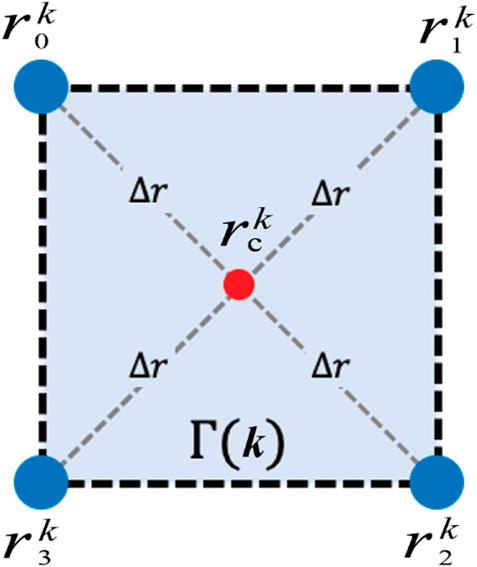
Figure 1. A symmetric formation composed of four mobile robots
In this work, to facilitate the implementation of the PPO algorithm for source mapping in Section 4.1, we discretize the global field
Assumption 2.2. Robots travel in a coordinate formation and the formation center moves along the eight possible directions “up”, “down”, “left”, “right”, “up-left”, “up-right”, “down-left”, “down-right” in the discretized domain.
With the robots moving in a formation, a CKF developed in (You et al., 2016; Wu et al., 2020) is employed to output estimates of concentration
Remark 2.1. Multi-robot formation control is a well-studied topic and researchers have developed numerous formation control algorithms (Zhang and Leonard, 2010; Ren and Beard, 2008; Wu and Zhang, 2012). In this work, we employ the formation control strategy developed in (Zhang and Leonard, 2010) and applied in (Wu et al., 2020). The strategy uses the Jacobi transform to decouple the formation control from the motion control of the multi-robot formation, which enables us to only plan the path and design the controller for the formation center
In real-world scenarios, the task of mapping complex dynamic fields for cases like gas-leaking and wildfires is important and is often time-critical. It is essential for the robot formation to explore and detect diffusion sources in unknown areas and generate a map as quickly as possible. With the field defined in Section 2.1 and the multi-robot formation defined in Section 2.2, the goal of this study is to design a path for the multi-robot formation so that the formation can identify the multiple non-overlapping diffusion sources in the dynamic field and reconstruct the field in real-time with the limited concentration measurements collected by the multi-robot formation along its trajectory. To achieve the goal, we will introduce a two-mode strategy in Section 4, which consists of a Source Mapping mode and a Field Exploration mode. In the Source Mapping mode, we employ the RL-based algorithm and train a PPO model to guide the multi-robot formation toward a diffusion source in the field and reach a stationary state, where the formation arrives at the source and moves with the field at the same speed as the advection flow. In the Field Exploration mode, we develop a K-means clustering-based exploration strategy to enable efficient exploration of unknown areas.
PPO (Schulman et al., 2017) is a significant development in reinforcement learning, introduced as a more efficient and simpler alternative to Trust Region Policy Optimization (TRPO) (Schulman et al., 2015). PPO is based on the policy gradient approach, a class of algorithms that optimize policies by directly computing gradients of expected rewards for policy parameters. This approach allows the learning agent to improve its policy iteratively by following the gradient of expected rewards. PPO enhances this process by addressing the complexities of earlier methods while retaining their benefits, particularly in maintaining stable and reliable policy updates.
PPO operates as an on-policy method. Unlike traditional policy gradient methods that apply a single update after each interaction with the environment, PPO refines the policy by using multiple updates on the same batch of data. The core of PPO is its surrogate objective function, designed to prevent large, potentially destructive policy updates. This is achieved through a probability ratio
In Equation 5,
Cooperative Kalman Filter (CKF) is a collaborative state estimation scheme first developed in (Zhang and Leonard, 2010), then used in later studies (Wu and Zhang, 2012; You et al., 2016; Wu et al., 2020; You et al., 2022), by combining live sensor data collected by the network of multiple mobile robots to collaboratively improve the accuracy of the state estimation process. In particular, when applied to the state estimation in dynamic fields, the authors incorporated the dynamics of the mobile robot formation and the diffusion equation into the formulation of the state equation of the CKF. This integration facilitates reliable and accurate state estimation, taking into account how changes in diffusion fields and the formation trajectory over time affect sensor data measurements. More specifically, the state vector
where
In this section, we introduce the proposed path-planning algorithm for guiding the mobile sensing robot formation to quickly explore an open field while reliably mapping and reconstructing all detected diffusion sources along its trajectory. The algorithm aims to find a balance between speed and reliability for the dynamic field reconstruction. To achieve this, the solution alternates the robot formation between two operational modes: Map Exploration and Source Mapping. In Map Exploration, the robots systematically advance toward unexplored regions to detect new diffusion fields. Upon detecting a new diffusion field, the system transitions to Source Mapping, where the formation converges on the field’s center to achieve a stationary state, necessary for estimating advection coefficients.
Throughout both modes, the robots continuously collect data, using the CKF for real-time concentration and gradient estimation and the RLS algorithm for identifying diffusion coefficients. In the discrete simulation environment, concentration estimates are interpolated across the formation’s view-scope. Mode transitions are based on the formation’s state and the concentration estimates at its center. Figure 2 provides an overview of all major components in our algorithm and their interaction within the two operation modes. In the following sections, we will provide details of the algorithms developed for the two modes.

Figure 2. Flow chart showing the key components of our algorithm and two operation modes of the robot formation.
As discussed in the high-level overview, the goal of the formation in Source Mapping mode is to move toward the source of a diffusion field and facilitate diffusion field reconstruction by estimating advection and diffusion parameters. For this purpose, we train a PPO model that takes the field information vector state to predict the optimal action. In this section, we describe the setup of our training environment and the architecture of our PPO model.
We define the observation input state
where
For every time step, our robot formation can move to any adjacent cells (including diagonal) or stay at the current location. Thus, we can define the action space
Since our goal is to train a PPO model that can guide the formation toward the center of a diffusion field and maintain stationary state as long as possible, it is crucial to develop a reward function that incentivizes this behavior. For this reason, we model the reward function based on the concentration values inside the formation view-scope as follows:
where
Using the trained PPO model, the robot formation takes actions chosen from the action space in Equation 7, and is guided toward the source of the diffusion field until it reaches the stationary state. This stationary state is achieved when the estimated field concentration reaches a local maximum and the estimated field gradient approaches zero, i.e.,
Whenever the robot formation reaches a stationary state, indicating the detection of the source of a diffusion field, the robot formation switches back to Field Exploration mode and moves toward unexplored area in the map to look for the remaining diffusion fields. During this phase, it is essential for the robot formation to come up with a new destination that is away from the already explored locations to avoid revisiting the same source, but also not too far to cause the formation to go back and forth when scanning the whole map. In short, our main objective is to generate a path that allows our robot formation to scan the whole field as quickly as possible without leaving any diffusion field undetected. Lawn mowing is a good example of generating a deterministic trajectory for scanning an unknown map. However, since our mobile sensing robots are often deployed in time-critical missions. It is necessary to opt for a more aggressive exploration strategy that allows the formation to discover all sources as quickly as possible. In our algorithm, we partition the unvisited cells in the entire map into multiple clusters using the K-Means clustering algorithm (Na et al., 2010). The selection of
After partitioning the map, the robot formation selects the centroid of the nearest cluster as the new destination and moves toward that destination to explore the field. It continues to visit the centroids of other clusters, prioritizing nearby clusters, as long as it is in the Field Exploration mode. The formation switches to Source Mapping mode when the estimated field concentration value exceeds a chosen threshold, i.e.,
Whenever a switch occurs from Field Exploration mode to Source Mapping mode and the formation reaches the stationary state in the Source Mapping mode (indicating a new diffusion field is detected), the robot formation evaluates the field and computes a new estimated
With the size of the latest detected diffusion field calculated based on Equation 10, we can update the estimated average size of the diffusion field
where
The field reconstruction begins when the formation detects the source of a diffusion field within the global domain. Given that our environment is modeled as a 2D grid, we discretize the diffusion Equation 1 to enable field reconstruction. Assuming the domain of interest
where
To reconstruct a diffusion field using the measurements taken by the robot formation with Equation 13, we need the estimated field concentration values
With these values determined, the field values across the diffusion field can be propagated through Equation 13. This approach enables field reconstruction using only the sparse measurements gathered along the robots’ paths.
In this section, we provide a comprehensive analysis of the proposed multi-robot field reconstruction strategy, which encompasses source mapping and field exploration modes in simulations. We begin by outlining the implementation details, followed by a discussion on the PPO training specifics. Finally, we present the results derived from these simulations.
To assess the overall solution, we developed a low-fidelity simulation environment within a discrete space. This environment is structured as a
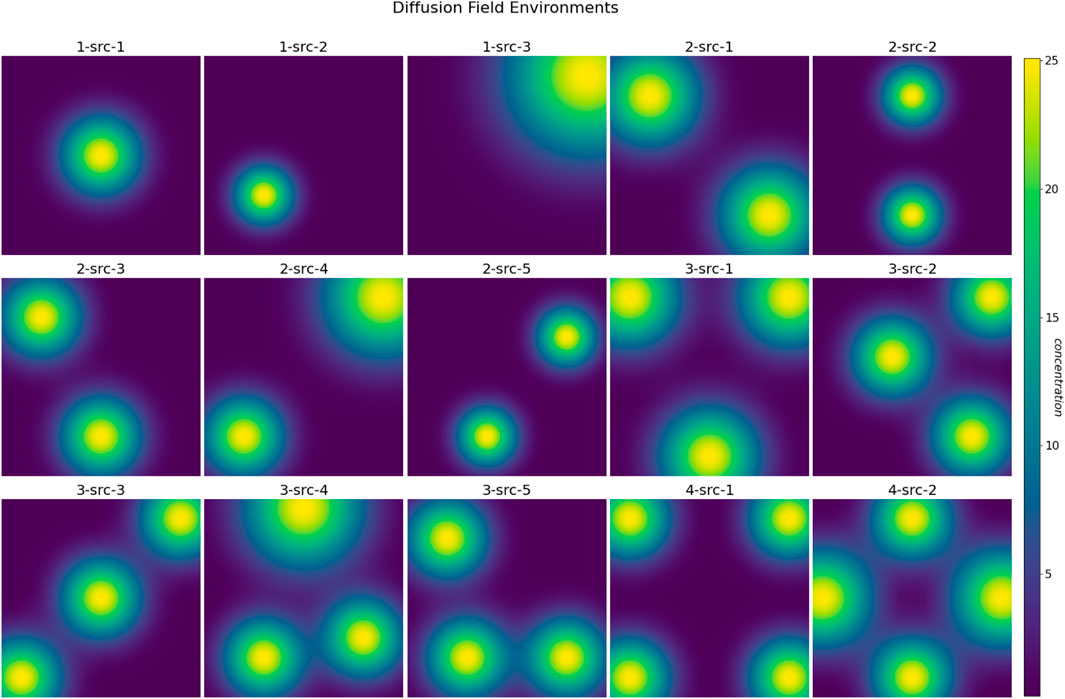
Figure 5. A set of 15 simulation environments, each consisting of one to four diffusion fields centered at various locations with distinct diffusion and advection coefficients.

Table 1. Configurations of the 15 diffusion field environments with advection terms
Since the map is discretized in our approach, selecting an appropriate grid cell size also plays a role in both the accuracy of data collection and computational efficiency. Each grid cell should be small enough to capture meaningful concentration gradients but large enough to reduce computational demands. Ideally, the grid cell size should reflect both the overall map dimensions and the characteristics of the environment being monitored. For example, when studying gas leaks, where subtle concentration changes are significant, a finer grid may be required. On the other hand, wildfire propagation fields, which tend to cover larger areas, can accommodate slightly larger cells. Adjusting the grid cell size based on the specific characteristics of the environment allows us to find the right balance between resolution and computational cost, facilitating effective and efficient exploration and reconstruction.
For the training of the PPO model, we follow a curriculum learning approach (Wang et al., 2023; Wang et al., 2022) that involves gradually increasing the complexity of the training environment. We created a
We simulate a group of four mobile robots in a symmetric formation as shown in Figure 1 to move in the environments, with the formation controller running to maintain the desired formation. With the CKF providing the state
We provide the training results in Figure 7. The PPO model was initially trained for 400,000 time steps on the static environment where advection terms are set to zero, as shown in Figure 7A. After that, we proceeded to train the PPO model on the dynamic environment for an additional 2,000,000 time steps, as shown in Figure 7B The model was trained multiple times with orthogonal random weight initialization using the Stable-Baselines3 framework (Raffin et al., 2021), and the best-performing model was selected for use in our experiments. In both environments, the formation is initially placed in a low-concentration region at the start of each episode to avoid starting too close to the source. Additionally, in our dynamic environment, the source is assigned random, non-zero advection and diffusion coefficients, causing it to move in a different direction in each episode. This setup encourages the model to adapt to various scenarios but also introduces some fluctuations in performance early in training, as the formation may take suboptimal actions initially and struggle to catch up to the moving source. In both training phases, however, the average reward per episode increases steadily, indicating that the model successfully improves its given task over time. Additionally, Figure 7C provide some samples of source-heading operation performed by our PPO model post-training. In these samples, the 4-robot formation, shown as the red square in the map, are tasked with locating the source while maintaining its formation. The yellow region denotes the area with high concentration - where the source is located, the red square represents the robot formation, and the red dot is the starting position of the formation center. The robot formation is directed towards the center of the source, which has maximum concentration, per the PPO’s objective of reward maximization. PPO’s role in this task is to update the policy per iteration to make an informed decision on where to go next. The simulation results show the PPO algorithm’s efficacy in source mapping.
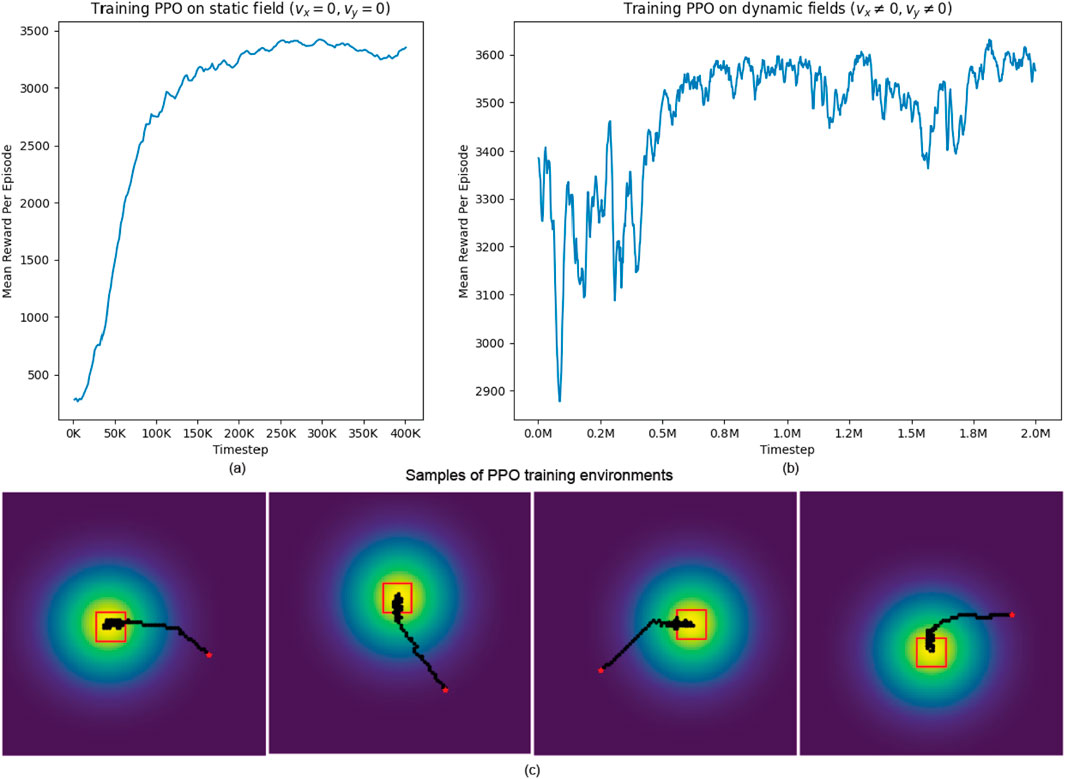
Figure 7. (A) Stage 1: Pre-training PPO on static fields. (B) Stage 2: Training PPO on dynamic fields. (C) Samples of training environments and generated trajectories post-training.
The PPO algorithm’s training process effectively learns a policy that guides the robot formation to explore the field, detect diffusion sources, and assist in reconstruction while adapting to dynamic changes in the environment. The algorithm’s capability in handling complex and dynamic environments indicates its potential in real-life scenarios where rapid environmental change happens, and accurate detection of diffusion sources is crucial. This capability is precious in pollution tracking or gas leak detection scenarios, where time-sensitive and precise localization is essential.
When the PPO model leads the robot formation to move toward a diffusion source and the formation center reaches the stationary state, the advection coefficient can be estimated based on Equation 14, and the field reconstruction process can start using Equation 13. Along with the field reconstruction process, the robot formation switches to the field exploration mode, where the K-means clustering-based exploration algorithm 2 plays a role.
Figure 8 provides an example of how the K-means clustering-based exploration works in a

Figure 8. Field Re-partitioning Behavior of the Exploration Module using K-Mean Clustering. The red dot is the starting position of the formation center. Partitioning happens at the beginning of an episode and whenever a new source is detected. (A) The trajectory of the formation center. (B) The initial partition of the field. (C) The updated partition after the first source on the upper right corner is detected. (D) The updated partition after the second source on the lower left corner is detected.
With the trained PPO model and the K-means clustering-based exploration algorithm, we now ready to implement the overall multi-robot Source Mapping and Field Exploration strategy to reconstruct a dynamic field. Figure 9 shows different trajectories of the robot formation obtained from the simulation across multiple spatial-diffusion environments. In this setup, the robot formation started at the same initial position
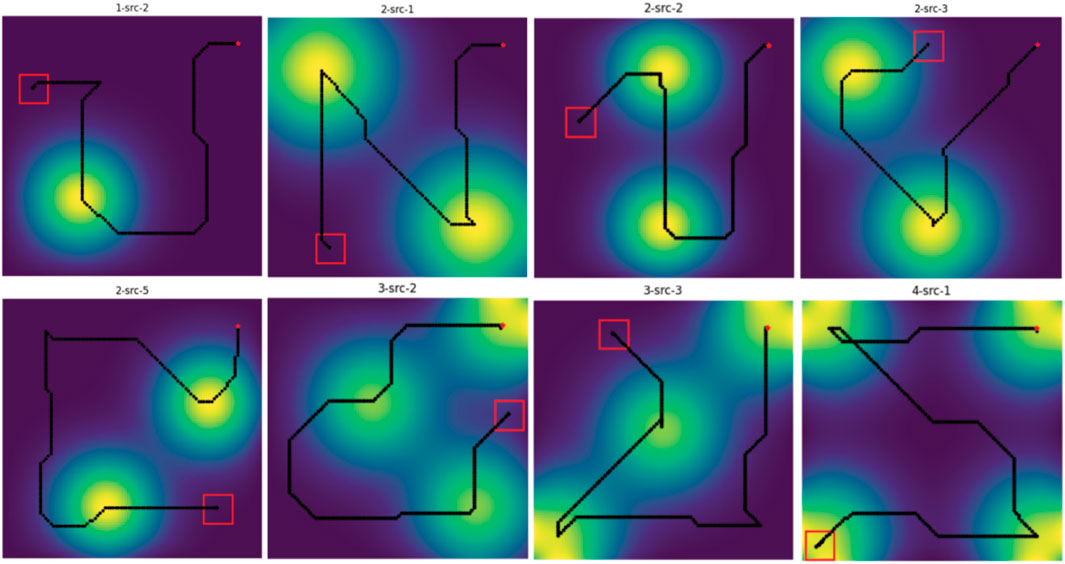
Figure 9. Generated trajectories obtained from simulations across different spatial-diffusion environments. The robot formation center is initially located at
In Figure 10, we compare the trajectory and mapping errors of our solution against other alternative path-planning algorithms, including Random-Walking (shown in black) and Lawn-Mowing (shown in green). With the Random-Walking strategy, the formation takes a random action in every time-step, resulting in an arbitrary trajectory. On the other hand, with Lawn-Mowing strategy, the formation attempts to scan the field row-by-row until the entire field is fully covered. Compared to these approaches, the trajectory generated by our solution is faster at detecting and mapping diffusion fields, resulting in a much lower mapping error. In this map, our K-Mean-based approach is the only one that detects all diffusion fields before the episode ends
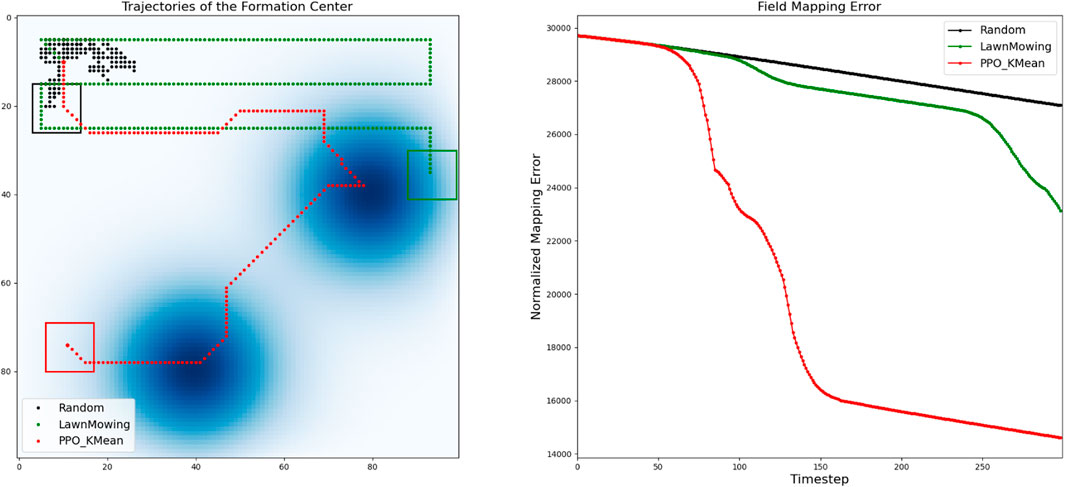
Figure 10. Analysis of the generated trajectory and mapping errors of our solution in comparison with the Lawn Mowing and Random Walking approaches.
To validate our solution in a real-world setting, we developed a high-fidelity testing environment in our lab. Our setup includes four mobile robots operating in a 12 × 12 square foot open field that simulates an actual advection-diffusion environment. Figure 11 shows our laboratory setup of the mobile sensor network consisting of 4 mobile robots with motion tracking enabled, allowing for accurate collection of real-time trajectory data. The robots are two-wheel differential drive and ROS-based, running on the Jetson Nano (Developer Nvidia, 2024) computing platform. Each robot is equipped with a 2D Lidar scanner [YDLidar-G4 (YDLIDAR-G4-Datasheet, 2024)], a speed encoder, and an IMU (BNO-055 (Industries, 2024)). To enable low-latency sensor fusion, a Teensy 4.0 (PJRC, 2024) collects and preprocesses sensor readings from the speed encoder and IMU before streaming the results to the main board via rosserial. Lidar is installed to enable basic obstacle avoidance behaviors, allowing the formation to adapt to various scenarios when navigating in outdoor environments.
For localization, we rely on an indoor motion capture system to provide absolute positional tracking, analogous to GPS in outdoor scenarios. An Extended Kalman Filter (Ribeiro, 2004) fuses data from both the IMU and motion capture system to improve real-time position estimation of the robots. Our software stack uses ROS Noetic (Quigley et al., 2009) and its ecosystem to facilitate sensor fusion for localization and obstacle avoidance, as well as to simulate and visualize the behaviors of the advection-diffusion field. In our stack, each robot has its own action server (based on ROS Action), which is responsible for moving the robot to a target destination. A master node running on a stand-alone computer is responsible for broadcasting the concentration values of the simulated field as well as performing formation control during the experiment.
Figure 12 presents various views of the simulated spatial-temporal diffusion field in our laboratory as well as an example of the trajectory generated by our robot formation. Given the difficulties of installing physical diffusion field sources indoors, we utilized computational models to simulate the environment. The simulated field is projected onto the floor in real-time footage captured by side and top-down cameras. Sensor measurements are generated based on the robots’ locations, which are tracked using the motion capture system.

Figure 12. (a) Lab experiment setup with a projected dynamic field and four mobile robots. (b) Snapshots of the trajectories of the robot formation at three different time steps in an experiment. The red dashed lines represent the trajectories.
To validate our solution in real-world settings, we selected two spatial-diffusion environments from our list and ran simulation experiments using actual mobile robots. While the spatial-temporal diffusion field is generated by computer simulation, the mobile sensor network is still designed to function exactly like how they should behave in the real-world. This involves having individual mobile robots take raw measurements and combine the results to estimate the concentration and gradients at the formation center, using CKF. Figure 13 provides a summary of our experimental results. The first column “Environment Field End State” shows the final states of our spatial diffusion environments and the trajectories of the robot formation. In both experiments, the formation enters the map from the bottom right corner with
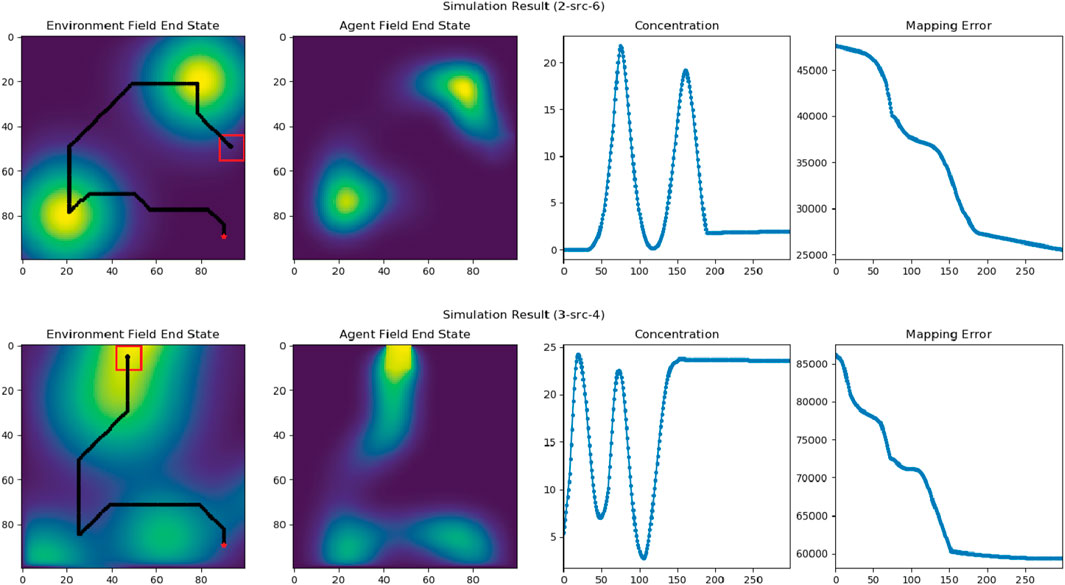
Figure 13. The field exploration and reconstruction results in two experiments with two and three diffusion sources. “Environment Field End State” figures illustrate the end states of the two experiments with corresponding trajectories of the robot formation. The red dots indicate the starting locations of the formation center and the red squares are the ending locations of the formation. “Agent Field End State” figures show the end states of the reconstructed fields in the two experiments. “Concentration” figures illustrate the estimated field concentration along the trajectories of the formation center, and “Mapping Error” figures show the mapping errors while reconstructing the fields.
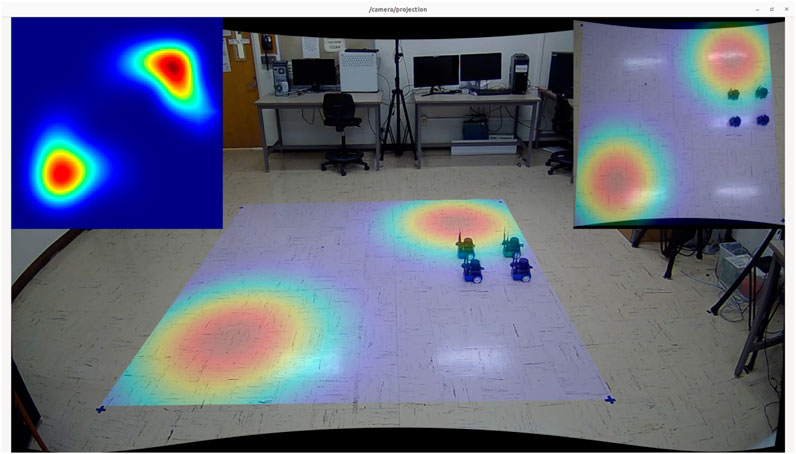
Figure 14. Screenshot captured from the experiment on the first environment with two diffusion fields.
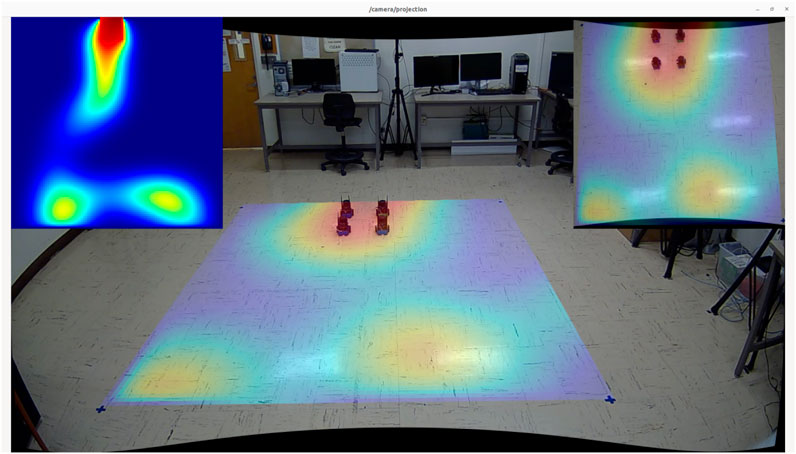
Figure 15. Screenshot captured from the experiment on the second environment with three diffusion fields.
In this paper, we developed a strategy to map and reconstruct dynamic fields with multiple diffusion sources using a multi-robot formation. This strategy proved effective on various maps with different configurations. Our approach efficiently explores unknown maps while ensuring that potential diffusion sources are detected. The results from our experiments show that the robot formation can effectively utilize environment data from all robots to navigate toward the source center and accurately reconstruct the advection and diffusion coefficients. While we did encounter some challenges with overlapping diffusion fields, these complexities only underscore the need for further research and detailed experiments. Our system holds potential for practical use in scenarios like rescue missions and field explorations, where robots can assess hazards before sending humans into these environments. This research shows the capability and versatility of our multi-robot system in environmental monitoring and could be important in enhancing safety measures during high-risk missions.
The raw data supporting the conclusions of this article will be made available by the authors, without undue reservation.
TL: Writing–original draft, Formal Analysis, Methodology, Software, Validation, Visualization, Data curation. DS: Writing–original draft, Formal Analysis, Software, Validation, Visualization. DT: Writing–review and editing, Methodology, Software. WW: Writing–original draft, Conceptualization, Data curation, Formal Analysis, Funding acquisition, Investigation, Methodology, Project administration, Resources, Software, Supervision, Validation, Visualization.
The author(s) declare that financial support was received for the research, authorship, and/or publication of this article. The research work is supported by NSF grants CMMI-1917300 and RINGS-2148353.
The authors declare that the research was conducted in the absence of any commercial or financial relationships that could be construed as a potential conflict of interest.
All claims expressed in this article are solely those of the authors and do not necessarily represent those of their affiliated organizations, or those of the publisher, the editors and the reviewers. Any product that may be evaluated in this article, or claim that may be made by its manufacturer, is not guaranteed or endorsed by the publisher.
Agarap, A. F. (2018). Deep learning using rectified linear units (ReLU). CoRR abs/1803 08375. doi:10.48550/arXiv.1803.08375
Bi, Q., Zhang, X., Wen, J., Pan, Z., Zhang, S., Wang, R., et al. (2024). Cure: a hierarchical framework for multi-robot autonomous exploration inspired by centroids of unknown regions. IEEE Trans. Automation Sci. Eng. 21 (3), 3773–3786. doi:10.1109/tase.2023.3285300
Burgard, W., Moors, M., Stachniss, C., and Schneider, F. (2005). Coordinated multi-robot exploration. Robotics, IEEE Trans.21, 376–386. doi:10.1109/tro.2004.839232
Cao, X., Li, M., Tao, Y., and Lu, P. (2024). Hma-sar: multi-agent search and rescue for unknown located dynamic targets in completely unknown environments. IEEE Robotics Automation Lett. 9 (6), 5567–5574. doi:10.1109/lra.2024.3396097
Chen, L., Dai, S.-L., and Dong, C. (2024). Adaptive optimal tracking control of an underactuated surface vessel using actor–critic reinforcement learning. IEEE Trans. Neural Netw. Learn. Syst. 35 (6), 7520–7533. doi:10.1109/tnnls.2022.3214681
Christopoulos, V., and Roumeliotis, S. (2005). Adaptive sensing for instantaneous gas release parameter estimation, 4450–4456.
Demetriou, M. A., Gatsonis, N. A., and Court, J. R. (2013). Coupled controls-computational fluids approach for the estimation of the concentration from a moving gaseous source in a 2-D domain with a Lyapunov-guided sensing aerial vehicle. IEEE Trans. Control Syst. Technol. 22 (3), 853–867. doi:10.1109/tcst.2013.2267623
Developer Nvidia (2024). Developer Nvidia. Available at: https://developer.nvidia.com/embedded/jetson-nano (Accessed January 9, 2024).
Dunbabin, M., and Marques, L. (2012). Robots for environmental monitoring: significant advancements and applications. IEEE Robot. Autom. Mag. 19 (1), 24–39. doi:10.1109/mra.2011.2181683
Gautam, A., Shekhawat, V. S., and Mohan, S. (2019). “A graph partitioning approach for fast exploration with multi-robot coordination,” in 2019 IEEE international conference on systems, man and cybernetics (SMC), 459–465.
Hu, Y., Fu, J., and Wen, G. (2023). Graph soft actor–critic reinforcement learning for large-scale distributed multirobot coordination. IEEE Trans. Neural Netw. Learn. Syst., 1–12. doi:10.1109/TNNLS.2023.3329530
Industries, A. (2024). Adafruit 9-dof absolute orientation imu fusion breakout - bno055. Available at: https://www.adafruit.com/product/4646 (Accessed January 9, 2024).
Khaled, C., Mustapha, E.-R., and Olivier, (2004). On the rate of spread for some reaction-diffusion models of forest fire propagation. Numer. Heat. Transf. Part A Appl. 46 (8), 765–784. doi:10.1080/104077890504456
Kinaneva, D., Hristov, G., Raychev, J., and Zahariev, P. (2019). “Early forest fire detection using drones and artificial intelligence,” in 2019 42nd international convention on information and communication technology, electronics and microelectronics MIPRO Opatija, Croatia, 1060–1065.
Kingma, D., and Ba, J. (2015). “Adam: a method for stochastic optimization,” in International conference on learning representations (ICLR) (San Diega, CA, USA).
Long, J., and Zhang, B. (2024). “Multi-robots path planning and mapping for exploring unknown environment,” in 2024 7th international conference on intelligent robotics and control engineering (IRCE), 72–76.
Luvisutto, A., Shehhi, A. A., Mankovskii, N., Renda, F., Stefanini, C., and De Masi, G. (2022). “Robotic swarm for marine and submarine missions: challenges and perspectives,” in 2022 IEEE/OES autonomous underwater vehicles symposium (AUV), 1–8.
Martins, A., Almeida, J., Almeida, C., Dias, A., Dias, N., Aaltonen, J., et al. (2018). “Ux 1 system design - a robotic system for underwater mining exploration,” in IEEE/RSJ international conference on intelligent robots and systems IROS, 1494–1500.
Mourikis, A., and Roumeliotis, S. (2006). Performance analysis of multirobot cooperative localization. IEEE Trans. Robotics 22 (4), 666–681. doi:10.1109/tro.2006.878957
Na, S., Xumin, L., and Yong, G. (2010). “Research on k-means clustering algorithm: an improved k-means clustering algorithm,” in 2010 third international symposium on intelligent information technology and security informatics, 63–67.
Niroui, F., Zhang, K., Kashino, Z., and Nejat, G. (2019). Deep reinforcement learning robot for search and rescue applications: exploration in unknown cluttered environments. IEEE Robotics Automation Lett. 4 (2), 610–617. doi:10.1109/lra.2019.2891991
PJRC (2024). Teensy® 4.0 development board. Available at: https://www.pjrc.com/store/teensy40.html (Accessed on January 9, 2024).
Queralta, J. P., Taipalmaa, J., Can Pullinen, B., Sarker, V. K., Nguyen Gia, T., Tenhunen, H., et al. (2020). Collaborative multi-robot search and rescue: planning, coordination, perception, and active vision. IEEE Access 8, 191617–191643. doi:10.1109/access.2020.3030190
Quigley, M., Conley, K., Gerkey, B. P., Faust, J., Foote, T., Leibs, J., et al. (2009). “ROS: an open-source robot operating system,” in ICRA workshop on open source software.
Raffin, A., Hill, A., Gleave, A., Kanervisto, A., Ernestus, M., and Dormann, N. (2021). Stable-baselines3: reliable reinforcement learning implementations. J. Mach. Learn. Res. 22 (268), 1–8. doi:10.5555/3546258.3546526
Reisch, C., Navas-Montilla, A., and Özgen Xian, I. (2024). Analytical and numerical insights into wildfire dynamics: exploring the advection–diffusion–reaction model. Comput. Math. Appl. 158, 179–198. doi:10.1016/j.camwa.2024.01.024
Ren, W., and Beard, R. W. (2008). Distributed consensus in multi-vehicle cooperative control, 27. Springer.
Ribeiro, M. I. (2004). Kalman and extended kalman filters: concept, derivation and properties. Inst. Syst. Robotics 43 (46), 3736–3741.
Rossi, M., and Brunelli, D. (2016). Autonomous gas detection and mapping with unmanned aerial vehicles. IEEE Trans. Instrum. Meas. 65 (4), 765–775. doi:10.1109/tim.2015.2506319
Schulman, J., Levine, S., Moritz, P., Jordan, M., and Abbeel, P. (2015). “Trust region policy optimization,” in Proceedings of the 32nd international Conference on international Conference on machine learning - volume 37, Lille, France ICML’15 (JMLR.org), 1889–1897.
Schulman, J., Wolski, F., Dhariwal, P., Radford, A., and Klimov, O. (2017). Proximal policy optimization algorithms. CoRR abs/1707, 06347. doi:10.48550/arXiv.1707.06347
Shuvo, M. I. R., Wimer, B., Mahmud, S., and Kim, J.-H. (2023). “A novel collaborative knowledge sharing and self-learning framework for robotic systems in search and rescue operations,” in IECON 2023- 49th annual conference of the IEEE industrial electronics society, 1–6.
Talwar, D. (2020). Deep reinforcement learning based path-planning for multi-agent systems in advection-diffusion field reconstruction tasks.
Tricaud, C., and Chen, Y. Q. (2010). “Optimal trajectories of mobile remote sensors for parameter estimation in distributed cyber-physical systems,” in Proceedings of the 2010 American control conference, 3211–3216.
Ucinski, D. (2005). “Optimal measurement methods for distributed parameter system identification,” in Taylor and Francis series in systems and control. Boca Raton, Fla: CRC Press.
Ucinski, D., and Chen, Y. (2005). “Time-optimal path planning of moving sensors for parameter estimation of distributed systems,” in Proceedings of the 44th IEEE conference on decision and control, 5257–5262.
Wang, H.-C., Huang, S.-C., Huang, P.-J., Wang, K.-L., Teng, Y.-C., Ko, Y.-T., et al. (2023). Curriculum reinforcement learning from avoiding collisions to navigating among movable obstacles in diverse environments. IEEE Robotics Automation Lett. 8 (5), 2740–2747. doi:10.1109/lra.2023.3251193
Wang, X., Chen, Y., and Zhu, W. (2022). A survey on curriculum learning. IEEE Trans. Pattern Analysis Mach. Intell. 44 (9), 4555–4576. doi:10.1109/TPAMI.2021.3069908
Wu, W., You, J., Zhang, Y., Li, M., and Su, K. (2020). Parameter identification of spatial–temporal varying processes by a multi-robot system in realistic diffusion fields. Robotica 39, 842–861. doi:10.1017/s0263574720000788
Wu, W., and Zhang, F. (2012). Robust cooperative exploration with a switching strategy. IEEE Trans. Robotics 28 (4), 828–839. doi:10.1109/tro.2012.2190182
YDLIDAR-G4-Datasheet (2024). YDLIDAR-G4-Datasheet. Available at: http://www.ydlidar.com/Public/upload/files/2020-04-13/YDLIDAR%20G4%20Datasheet.pdf (Accessed on January 9, 2024).
You, J., and Wu, W. (2018). “Geometric reinforcement learning based path planning for mobile sensor networks in advection-diffusion field reconstruction,” in 2018 IEEE conference on decision and control (CDC) (IEEE), 1949–1954.
You, J., Zhang, F., and Wu, W. (2016). “Cooperative filtering for parameter identification of diffusion processes,” in 2016 IEEE 55th conference on decision and control IEEE: CDC, 4327–4333.
You, J., Zhang, Z., Zhang, F., and Wu, W. (2022). Cooperative filtering and parameter identification for advection–diffusion processes using a mobile sensor network. IEEE Trans. Control Syst. Technol. 31 (2), 527–542. doi:10.1109/tcst.2022.3183585
Zhang, F., and Leonard, N. E. (2010). Cooperative filters and control for cooperative exploration. IEEE Trans. Automatic Control 55 (3), 650–663. doi:10.1109/tac.2009.2039240
Zhang, Z., Mayberry, S. T., Wu, W., and Zhang, F. (2023). Distributed cooperative kalman filter constrained by advection–diffusion equation for mobile sensor networks. Front. Robotics AI 10, 1175418. doi:10.3389/frobt.2023.1175418
Keywords: multi-robot systems, mobile sensor networks, reinforcement learning, dynamic field reconstruction, source seeking, environmental monitoring
Citation: Lu T, Sobti D, Talwar D and Wu W (2025) Reinforcement learning-based dynamic field exploration and reconstruction using multi-robot systems for environmental monitoring. Front. Robot. AI 12:1492526. doi: 10.3389/frobt.2025.1492526
Received: 07 September 2024; Accepted: 17 February 2025;
Published: 25 March 2025.
Edited by:
Shude He, Guangzhou University, ChinaCopyright © 2025 Lu, Sobti, Talwar and Wu. This is an open-access article distributed under the terms of the Creative Commons Attribution License (CC BY). The use, distribution or reproduction in other forums is permitted, provided the original author(s) and the copyright owner(s) are credited and that the original publication in this journal is cited, in accordance with accepted academic practice. No use, distribution or reproduction is permitted which does not comply with these terms.
*Correspondence: Wencen Wu, d2VuY2VuLnd1QHNqc3UuZWR1
Disclaimer: All claims expressed in this article are solely those of the authors and do not necessarily represent those of their affiliated organizations, or those of the publisher, the editors and the reviewers. Any product that may be evaluated in this article or claim that may be made by its manufacturer is not guaranteed or endorsed by the publisher.
Research integrity at Frontiers

Learn more about the work of our research integrity team to safeguard the quality of each article we publish.